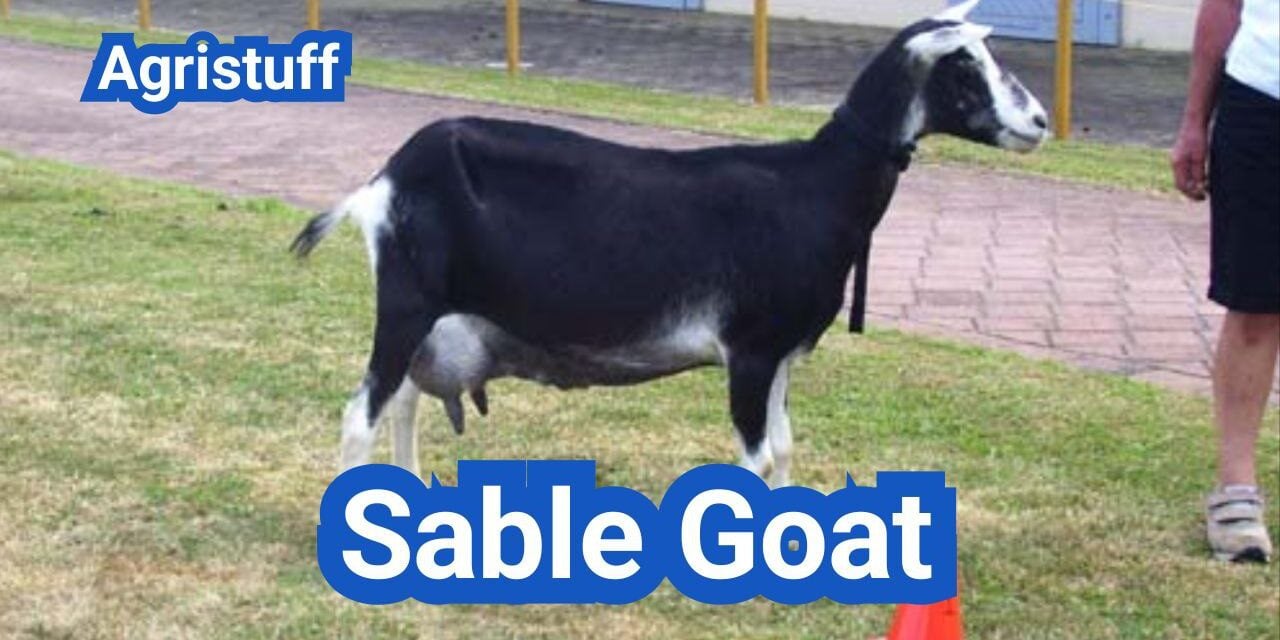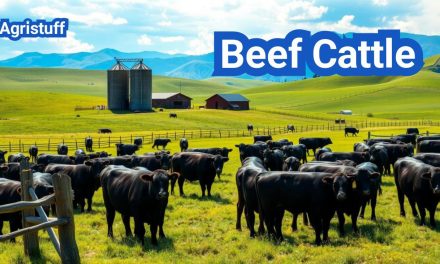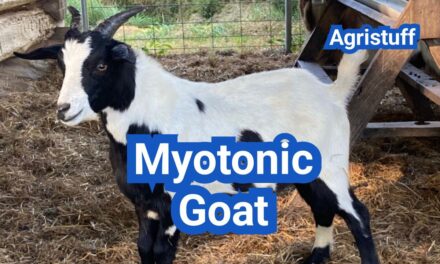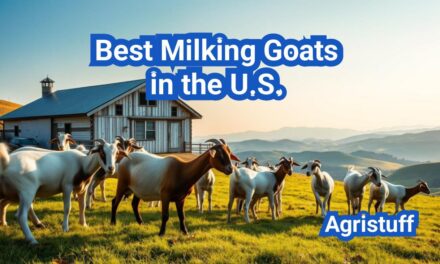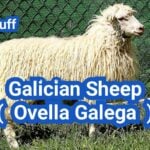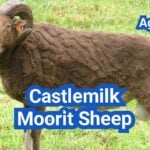The Sable Goat is a unique breed derived from the Saanen breed, known for its diverse coat colors and impressive dairy production capabilities.
Originating from the Saanen breed, Sable Goats have evolved with distinct characteristics that make them valuable for dairy farming. Their history and origin are closely tied to the development of dairy goat breeds.
Understanding the Sable Goat’s characteristics, breeding practices, and uses is essential for farmers and enthusiasts alike. This introduction provides an overview, setting the stage for a detailed exploration of this remarkable breed.
Key Takeaways
- Sable Goats are derived from the Saanen breed.
- They are known for their diverse coat colors.
- Sable Goats are valued for their dairy production capabilities.
- Understanding their characteristics and breeding is crucial.
- Sable Goats are an important part of dairy goat breeds.
What Is A Sable Goat?
Understanding the Sable Goat requires delving into its definition, classification, and its close relationship with Saanen Goats. The Sable Goat is essentially a colored variant of the Saanen breed, sharing the same Swiss origins.
Definition and Classification
The Sable Goat is defined as a Saanen with a colored coat. Despite their different appearance, Sables are classified alongside Saanens in many dairy goat registries. This classification underscores their shared heritage and characteristics.
Relationship to Saanen Goats
Sable Goats are genetically similar to Saanen Goats, with the primary difference being their coat color. This variation in coat color has led to the recognition of Sables as a distinct variant within the Saanen breed. The relationship between Sables and Saanens is crucial for breeders, as it influences breeding decisions and the overall quality of the dairy herd.
Brief Overview of Uses
Sable Goats are valued for their dairy production capabilities, similar to Saanen Goats. They are used in dairy farming for their milk, which is rich in quality and quantity. The milk from Sable Goats is used to produce a variety of dairy products, making them an important part of the dairy industry.
In summary, Sable Goats are colored Saanens with a strong dairy production profile. Their unique coat colors and genetic similarity to Saanens make them a valuable asset in dairy farming.
History and Origin of the Sable Goat

The Sable Goat has a fascinating history that is deeply intertwined with that of the Saanen goat. The Sable goat’s origin is rooted in the genetics of the Saanen breed, with the color gene being a significant factor in their development.
Development from Saanen Genetics
The Sable goat breed emerged from the Saanen genetics, primarily due to a genetic variation that resulted in a distinct coat color. This genetic diversity is a result of the natural variation within the Saanen breed, showcasing the complexity of their ancestry.
Saanen goats are known for their high milk production and robust health, traits that have been passed down to the Sable goats. The genetic link between the two breeds is evident in their physical characteristics and production capabilities.
The Controversy of Color
The color of Sable goats has been a subject of controversy, with some breeders initially viewing the colored variants as undesirable. However, the unique coloration has become a defining characteristic of the breed, distinguishing them from their Saanen ancestors.
The controversy surrounding the color of Sable goats highlights the complexities of breed development and the role of genetics in determining breed characteristics.
Recognition as a Distinct Breed
Over time, Sable goats have gained recognition as a distinct breed, thanks in part to the efforts of dedicated breeders and breed associations. This recognition has been crucial in establishing the breed’s identity and promoting its unique characteristics.
The process of achieving breed recognition involves rigorous breed standardization and documentation, ensuring that the breed maintains its integrity and consistency.
International Sable Breeders Association
The International Sable Breeders Association plays a vital role in promoting the Sable goat breed and supporting breeders worldwide. The association provides a platform for breeders to share knowledge, resources, and best practices, contributing to the breed’s global presence.
By fostering a community of Sable goat breeders, the International Sable Breeders Association helps to ensure the continued development and success of the breed.
Physical Characteristics of Sable Goats
Sable goats are characterized by their diverse range of sizes, weights, and coat colors. This diversity is a result of their genetic background, closely related to Saanen goats, but with the distinct difference of having colored coats.
Size and Weight
Sable goats are similar in size and weight to their Saanen counterparts. They typically range from medium to large in size. Does usually weigh between 100-150 pounds, while bucks can weigh between 150-200 pounds.
The size and weight of Sable goats can vary based on factors such as genetics, nutrition, and overall health. Proper care and management play a crucial role in ensuring that Sable goats achieve their optimal size and weight.
Coat Colors and Patterns
One of the most distinctive features of Sable goats is their coat color. Unlike Saanen goats, which are white, Sable goats can come in a variety of colors except white or light cream. Their coats can range from dark brown to black, and various shades of red and tan. The coat patterns can also vary, with some goats having solid colors, while others display a mix of colors or patterns.
Distinguishing Features
Sable goats have several distinguishing features that set them apart from other breeds. Their colored coats are the most obvious difference. Additionally, they often have a muscular build and a robust constitution, similar to Saanen goats.
Other distinguishing features include their alert posture and the shape and size of their ears and horns, if present.
Breed Standard
The breed standard for Sable goats is closely aligned with that of Saanen goats, with the primary difference being the acceptance of colored coats. The International Sable Breeders Association has established guidelines that define the breed characteristics, including size, weight, coat color, and overall conformation.
| Characteristic | Description |
|---|---|
| Size | Medium to large |
| Weight | Does: 100-150 pounds, Bucks: 150-200 pounds |
| Coat Color | Any color except white or light cream |
| Coat Pattern | Solid, mixed, or various patterns |
Sable Goat Temperament and Behavior

The temperament of Sable goats is one of their most appealing characteristics, showcasing their social and affectionate personalities. Sables are known for their friendly and social nature, similar to Saanens, making them an excellent choice for farmers and homesteaders who value interaction with their animals.
Personality Traits
Sable goats are characterized by their friendly and outgoing personalities. They are known to be curious and enjoy human interaction, often approaching people for attention or to explore their surroundings. This trait makes them relatively easy to handle, especially for those with experience in managing goats.
Their friendly nature also means they can be quite affectionate, often seeking out human contact and enjoying being petted or fed treats. However, like any animal, individual personalities can vary, and some Sables may be more reserved than others.
Social Behavior
Sable goats are highly social animals that thrive in the company of others. They have a natural instinct to form herds and establish a pecking order within their group. This social behavior is crucial for their well-being, and they can become stressed or anxious if isolated for too long.
In a farm or homestead setting, it’s essential to provide Sable goats with adequate social interaction, either by keeping them in groups or ensuring they have regular contact with other animals or humans.
Handling Considerations
Handling Sable goats requires a gentle and patient approach, taking into account their social and friendly nature. It’s crucial to move slowly and calmly around them to avoid startling them. Sables respond well to positive reinforcement, such as treats and praise, which can be used to encourage good behavior during handling.
Establishing a routine and being consistent in handling practices can also help in building trust between the goats and their handlers.
Family Compatibility
Sable goats can make an excellent addition to families, especially those with children, due to their gentle and affectionate nature. However, it’s essential to teach children how to interact with goats safely and respectfully, ensuring that both the children and the goats have a positive experience.
With proper care and attention, Sable goats can become beloved family pets, providing companionship and joy to those around them.
Sable Goat vs. Saanen: Key Differences
Sable goats and Saanen goats, while similar in some respects, exhibit several key differences that can impact farming decisions. The primary distinction lies in their coat color, with Sables being colored and Saanens being white or light cream. However, their differences extend beyond coat color to include production capabilities, breeding considerations, and more.
Physical Differences
The most noticeable physical difference between Sable goats and Saanen goats is their coat color. Sable goats can display a wide range of colors, including various shades of brown, black, and tan, while Saanen goats are characterized by their white or light cream coats. Additionally, while both breeds are of similar size and weight, subtle differences in their physical characteristics can be observed.
Production Capabilities
Both Sable and Saanen goats are known for their dairy production capabilities. However, the milk production levels can vary between the breeds. Saanen goats are often recognized for their high milk yield, but Sable goats offer the advantage of colored coats, which can be beneficial in certain farming contexts.
Breeding Considerations
When it comes to breeding, both Sable and Saanen goats have their considerations. The genetic diversity introduced by Sable goats can be advantageous, while the established dairy lineage of Saanen goats is also a significant factor. Farmers should consider their breeding goals and the characteristics they wish to emphasize in their herd.
Choosing Between Breeds
The decision between raising Sable goats or Saanen goats ultimately depends on the farmer’s specific needs and preferences. Factors such as market demand, farm conditions, and personal preference regarding coat color and breed characteristics play a crucial role. It’s essential to weigh these factors carefully to make an informed decision.
Setting Up Housing for Sable Goats

The housing of Sable goats is a critical aspect of their care, directly impacting their overall well-being. Proper housing ensures that these animals are protected from predators, harsh weather conditions, and diseases, thereby enhancing their productivity and longevity.
Shelter Requirements
Sable goats need sturdy shelters that can protect them from various environmental factors. The shelter should be well-ventilated to prevent the buildup of moisture and reduce the risk of respiratory issues. Adequate ventilation is crucial, and this can be achieved by ensuring there are sufficient openings or vents in the shelter.
The shelter’s design should also consider the local climate. For instance, in colder climates, insulation is key to maintaining a warm environment, while in hotter climates, shading and cooling measures are essential.
Fencing Needs
Fencing is a critical component of Sable goat housing, as it prevents escape and protects the goats from predators. The fencing should be at least 5 feet high to prevent jumping, and the material used should be durable and resistant to damage. High-tensile wire fencing is often recommended due to its strength and longevity.
Space Considerations
Adequate space is essential for the health and well-being of Sable goats. The housing area should provide enough room for the goats to move around comfortably. A general rule of thumb is to allocate at least 10 square feet per goat inside the shelter.
Outdoor areas should also be considered, with enough space for grazing and exercise. The total area required will depend on the number of goats and their breed characteristics.
Bedding and Maintenance
Bedding is an important aspect of Sable goat housing, as it provides comfort and helps maintain cleanliness. Common bedding materials include straw, hay, or sand. The bedding should be kept dry and clean to prevent health issues.
Regular maintenance of the housing area is crucial. This includes cleaning out bedding, disinfecting surfaces, and checking for any damage to the shelter or fencing. Regular inspections help identify potential issues before they become major problems.
Feeding Your Sable Goat: A Complete Guide

A well-balanced diet is crucial for the health and productivity of Sable goats. Sable goats, like their Saanen counterparts, require a diet rich in nutrients to support their growth, milk production, and overall health.
Basic Nutritional Requirements
Sable goats need a balanced diet that includes high-quality hay, grains, and access to fresh water. The nutritional requirements can vary based on factors such as age, size, and stage of production (e.g., lactation or pregnancy).
The basic nutritional components include:
- Carbohydrates for energy
- Proteins for growth and repair
- Fats for energy and vitamin absorption
- Vitamins and minerals for overall health
Daily Feeding Schedule
Establishing a consistent daily feeding schedule is essential for the health of Sable goats. The schedule should include:
- High-quality hay available at all times
- Grain feeding twice a day, adjusted according to production levels
- Access to fresh water at all times
A sample daily feeding schedule might look like this:
| Time | Feed Type | Quantity |
|---|---|---|
| Morning | Grain | 2 lbs |
| Evening | Grain | 2 lbs |
| All Day | Hay | Free Choice |
Supplements and Minerals
In addition to their regular diet, Sable goats may require supplements and minerals to ensure they are getting all the necessary nutrients. Common supplements include:
- Calcium and phosphorus for bone health
- Vitamins A and D for immune function and overall health
It’s essential to consult with a veterinarian or a qualified animal nutritionist to determine the best supplements for your Sable goats.
Water Requirements
Access to fresh, clean water is crucial for Sable goats. Water intake can vary based on factors such as temperature, humidity, and stage of production.
Tip: Ensure that water containers are clean and easily accessible to prevent health issues.
Health Management for Sable Goats
To ensure the longevity and productivity of Sable goats, a robust health management plan is essential. Effective health management involves understanding the common health issues that can affect Sable goats and implementing preventative measures to mitigate these risks.
Common Health Issues
Sable goats, like other goat breeds, are susceptible to various health issues, including parasites and diseases. Some of the most common health problems include internal parasites, respiratory infections, and hoof issues.
Internal Parasites: Sable goats are prone to internal parasites such as worms, which can lead to weight loss, decreased milk production, and other health complications. Regular monitoring and deworming are crucial.
Respiratory Infections: Respiratory diseases can be caused by bacteria, viruses, or fungi. Maintaining a clean living environment and ensuring good ventilation can help prevent these infections.
Hoof Issues: Hoof problems, such as hoof rot, can be painful for Sable goats and affect their overall health. Regular hoof trimming and maintaining dry living conditions can help prevent these issues.
Preventative Care
Preventative care is a critical component of health management for Sable goats. This includes regular vaccinations, parasite control measures, and maintaining a clean and healthy living environment.
- Regular vaccinations to protect against diseases
- Parasite control measures, including deworming and monitoring
- Maintaining a clean and dry living environment
- Providing a balanced diet to ensure nutritional health
Vaccination Schedule
Developing a vaccination schedule with a veterinarian is crucial for protecting Sable goats against diseases. The schedule should be tailored to the specific needs of the herd and the region.
| Vaccination | Frequency | Purpose |
|---|---|---|
| CDT Vaccine | Annually | Protects against Clostridium perfringens type C and D and tetanus |
| Booster Shots | As recommended | Boosts immunity against specific diseases |
Parasite Control
Effective parasite control involves a combination of management practices and, when necessary, the use of antiparasitic medications. Regular monitoring of the herd for signs of parasitism is essential.
By implementing a comprehensive health management plan that includes preventative care, vaccinations, and parasite control, Sable goat farmers can help ensure the health and productivity of their herd.
Breeding Sable Goats Successfully

Successful Sable goat breeding hinges on careful planning, precise timing, and a deep understanding of the breed’s characteristics. Breeding Sable goats is a complex process that requires attention to detail and a commitment to best practices.
Breeding Age and Season
Sable goats typically reach breeding age between 6 to 12 months, depending on factors such as nutrition and overall health. The ideal breeding season varies by region, but generally, breeders aim for a kidding season that avoids extreme weather conditions.
Key considerations for breeding age and season include:
- Does are usually bred during the fall season to kid in the spring.
- The breeding season can be adjusted based on the farm’s specific climate and management practices.
- Selecting the right breeding time is crucial for the health of both the doe and the kids.
Selecting Breeding Stock
Choosing the right breeding stock is fundamental to a successful Sable goat breeding program. Breeders should focus on selecting animals with desirable traits such as high milk production, good temperament, and conformity to breed standards.
When selecting breeding stock, consider the following:
- Genetic diversity to avoid inbreeding and promote a healthy gene pool.
- Production records to identify high-performing does.
- Physical characteristics that align with the breed standard.
Pregnancy and Kidding
Once bred, does require careful management throughout their pregnancy. This includes maintaining a balanced diet, ensuring adequate nutrition, and monitoring for any signs of complications.
Key aspects of pregnancy and kidding care include:
- Providing a clean, safe environment for kidding.
- Monitoring the doe’s health and nutritional needs during pregnancy.
- Assisting with kidding if necessary, while also knowing when to intervene minimally.
Kid Care Basics
The care provided to newborn kids is critical for their survival and development. Ensuring kids receive adequate colostrum, are kept warm, and are monitored for health issues are essential practices.
Basic kid care practices include:
- Ensuring kids receive colostrum within the first hour of birth.
- Monitoring kid health and addressing any issues promptly.
- Providing a clean, warm environment to reduce stress and promote growth.
The Sable Goat Milk Production Guide
Sable goats offer a unique combination of high milk production and rich milk quality, making them ideal for various dairy products. Their milk production capabilities are comparable to those of the Saanen breed, known for their high yield and quality.
Average Yield and Quality
Sable goats are recognized for their impressive milk yield, which is on par with Saanen goats. The average milk yield for Sable goats can range from 800 to 1,200 liters per lactation period, depending on factors such as genetics, nutrition, and management practices.
The quality of Sable goat milk is also noteworthy, with a rich composition that makes it suitable for a variety of dairy products. The milk contains a good balance of fat, protein, and other nutrients, making it an excellent choice for cheese production, butter, and other dairy delights.
Milking Techniques
Effective milking techniques are crucial for maximizing milk yield and maintaining the health of the udder. For Sable goats, a gentle and consistent milking routine is recommended. This includes:
- Pre-milking preparation to stimulate milk letdown
- Gentle milking to avoid causing stress or discomfort
- Post-milking care to prevent mastitis and promote udder health
Milk Handling and Storage
Proper handling and storage of Sable goat milk are essential to preserve its quality. This involves:
- Cooling the milk to a low temperature immediately after milking
- Storing the milk in clean, sanitized containers
- Keeping the storage area clean and at the appropriate temperature
Dairy Products from Sable Goat Milk
The rich and nutritious milk of Sable goats can be used to produce a variety of delicious dairy products. Some popular options include:
| Dairy Product | Description |
|---|---|
| Cheese | A rich and creamy cheese, ideal for grating or slicing |
| Butter | A smooth and flavorful butter, perfect for baking or cooking |
| Yogurt | A nutritious and delicious yogurt, great for snacking or as a base for smoothies |
In conclusion, Sable goats are an excellent choice for dairy farming due to their high milk production and the quality of their milk. By employing proper milking techniques, handling, and storage practices, farmers can produce a range of high-quality dairy products.
Raising Sable Goats for Small Homesteads

Sable goats are becoming increasingly popular among small homestead owners due to their manageable size and dairy production capabilities. This section will explore the feasibility of raising Sable goats on small homesteads, covering essential aspects such as space requirements, economic considerations, and sustainable practices.
Space and Resource Requirements
Raising Sable goats requires careful consideration of the available space and resources. A minimum of 1/4 acre per goat is recommended for grazing and exercise. However, this can vary depending on the quality of pasture and the availability of supplementary feed.
Key Considerations for Space:
- Adequate fencing to secure the grazing area
- Shelter from extreme weather conditions
- Access to clean water and nutritious feed
Economic Considerations
The economic viability of raising Sable goats on small homesteads depends on several factors, including the initial investment, ongoing expenses, and potential revenue streams. The initial setup cost includes purchasing goats, fencing, and shelter.
| Expense Category | Initial Cost | Ongoing Annual Cost |
|---|---|---|
| Goats | $500 – $1,000 | $0 (if not breeding) |
| Fencing | $1,000 – $2,000 | $100 – $200 (maintenance) |
| Feed and Supplies | $0 | $500 – $1,000 |
Integration with Other Farming Activities
Sable goats can be integrated with other farming activities, such as dairy production, meat production, or land management. This integration can enhance the overall efficiency and profitability of the homestead.
Benefits of Integration:
- Diverse income streams
- Improved land management through grazing
- Enhanced biodiversity
Sustainable Practices
Adopting sustainable practices is crucial for the long-term viability of Sable goat farming on small homesteads. This includes rotational grazing, organic feed, and minimizing waste.
Sustainable Practices to Consider:
- Rotational grazing to maintain pasture health
- Using organic and locally sourced feed
- Implementing efficient manure management systems
Establishing a Sable Goat Farm

Creating a successful Sable goat farm involves meticulous planning, from initial business planning to the marketing of the final products. This comprehensive approach ensures the sustainability and profitability of the farm.
Business Planning
A well-structured business plan is the foundation of any successful Sable goat farm. It should outline financial projections, including initial investment costs, ongoing expenses, and projected income from the sale of goats, milk, or other products.
Key components of a business plan for a Sable goat farm include:
- Market analysis to understand demand and competition
- Production costs, including feed, veterinary care, and equipment
- Marketing strategies to reach potential customers
- Financial projections, including income statements and cash flow forecasts
Herd Management
Effective herd management is crucial for the health and productivity of the goats. This includes selecting high-quality breeding stock, managing breeding programs, and ensuring proper nutrition and health care.
Best practices for herd management:
- Regular veterinary check-ups
- Proper feeding and nutrition planning
- Record keeping for breeding, health issues, and production
Marketing Sable Goat Products
Marketing is a critical aspect of establishing a successful Sable goat farm. Farmers can market their products directly to consumers, to dairy processors, or through other channels.
| Marketing Channel | Potential Customers | Benefits |
|---|---|---|
| Direct Sales | Consumers, local businesses | Higher profit margins, direct customer feedback |
| Dairy Processors | Cheese makers, yogurt producers | Stable demand, bulk sales |
| Online Platforms | Wide customer base | Broader reach, lower marketing costs |
Record Keeping
Accurate record keeping is essential for managing a Sable goat farm efficiently. Records should include financial data, production levels, breeding information, and health issues.
Types of records to keep:
- Financial records, including income and expenses
- Production records, such as milk yield and quality
- Breeding records, including mating dates and outcomes
- Health records, detailing vaccinations, treatments, and issues
Sable Goats in the United States

Sable goats, known for their rich milk production and friendly temperament, are making a significant impact on the US dairy scene. As a variant of the Saanen breed, they have gained popularity among farmers and homesteaders due to their unique characteristics and versatility.
Population and Distribution
The Sable goat population in the US is steadily increasing as more farmers recognize the benefits of raising these animals. They are distributed across various states, with a higher concentration in areas known for their dairy farming traditions. States like Wisconsin, New York, and California are among the top locations for Sable goat farming due to their favorable climate and existing agricultural infrastructure.
Breed Organizations
Several breed organizations play a crucial role in promoting and supporting the Sable goat breed in the United States. The American Sable Breeders Association is one such organization that works tirelessly to maintain breed standards, provide breeding resources, and host events for breeders. These organizations are vital in ensuring the continued growth and health of the Sable goat population.
Shows and Competitions
Sable goats participate in various agricultural shows and competitions across the US, where they are judged based on breed standards, milk production, and overall health. These events provide breeders with opportunities to showcase their animals, share knowledge, and network with other professionals in the industry. Competitions at the county and state fairs are particularly popular, offering a platform for both seasoned and novice breeders to demonstrate their expertise.
Finding Local Resources
For those interested in getting involved with Sable goats, finding local resources is a crucial step. Potential breeders can start by contacting local breed organizations, attending agricultural events, and connecting with experienced breeders. Online forums and social media groups dedicated to Sable goats can also provide valuable information and support.
As the Sable goat breed continues to gain popularity in the US, it’s essential for prospective owners to be well-informed about the resources available to them. By leveraging local networks and breed organizations, individuals can ensure they are well-equipped to care for these remarkable animals.
Beginner’s Guide to Sable Goat Ownership
As a beginner, navigating the world of Sable goat care can seem daunting, but it doesn’t have to be. With the right guidance, new owners can provide the appropriate care and management for their Sable goats, ensuring a healthy and thriving experience.
Essential Equipment Checklist
Before bringing home your Sable goats, it’s crucial to have the necessary equipment. This includes:
- Sturdy fencing to secure your goats
- A well-ventilated shelter to protect them from the elements
- Feeding troughs and buckets for nutrition
- Hoof trimming tools for regular maintenance
- First aid kits tailored to goat health needs
Daily Care Routine
A consistent daily routine is vital for the health and well-being of your Sable goats. This routine should include:
- Morning and evening feeding sessions
- Regular checks for signs of illness or stress
- Cleaning of living areas to prevent disease
- Providing fresh water at all times
- Monitoring and managing parasite control
Consistency is key to maintaining a healthy environment for your goats.
Common Beginner Mistakes
New owners should be aware of common pitfalls, such as:
- Underestimating the space and fencing needs
- Not providing adequate shelter
- Failing to establish a regular health check routine
- Overlooking the importance of proper nutrition
Avoiding these mistakes can significantly improve your Sable goat care experience.
Finding Mentors and Support
Connecting with experienced breeders and joining Sable goat communities can provide invaluable support. These networks can offer:
- Advice on best practices
- Guidance on health issues and solutions
- Opportunities for networking and learning
Engaging with the community can make a significant difference in your journey as a Sable goat owner.
Is the Sable Goat Right for You?
Sable goats offer a unique combination of dairy production and colorful appearance, making them a great choice for many farmers and homesteaders. When considering Choosing Sable Goats, it’s essential to evaluate your specific needs and circumstances.
The Sable Goat breed is known for its friendly temperament, high milk production, and striking coat colors. If you’re looking for a breed that can provide a sustainable source of dairy products while adding visual appeal to your farm or homestead, the Sable Goat is worth considering.
To determine Sable Goat Suitability for your operation, assess your available resources, including space, equipment, and expertise. With proper care and management, Sable Goats can thrive and provide numerous benefits.
By understanding the characteristics, needs, and advantages of Sable Goats, you can make an informed decision about whether this breed is the right fit for your agricultural endeavors.
FAQ
What is a Sable Goat?
A Sable Goat is a colored version of the Saanen goat breed, known for its dairy production capabilities and friendly temperament.
How did Sable Goats originate?
Sable Goats originated from Saanen genetics, with the colored offspring being recognized as a distinct breed due to their unique coat colors.
What are the physical characteristics of Sable Goats?
Sable Goats are medium-sized dairy goats with various coat colors, including brown, black, and red, and they have a sturdy build and a friendly disposition.
How much milk do Sable Goats produce?
Sable Goats are known for their good milk production, with an average yield that is comparable to Saanen goats, making them suitable for dairy farming.
What are the benefits of owning a Sable Goat?
Owning a Sable Goat can provide benefits such as milk production for dairy products, companionship, and the potential for sustainable farming practices.
How do I care for a Sable Goat?
Caring for a Sable Goat involves providing proper housing, nutrition, health management, and regular veterinary check-ups to ensure their well-being.
Can Sable Goats be raised on small homesteads?
Yes, Sable Goats can be raised on small homesteads, provided there is sufficient space, resources, and a suitable environment for them to thrive.
How do I breed Sable Goats successfully?
Successful breeding of Sable Goats involves selecting suitable breeding stock, managing pregnancy and kidding, and providing essential care for newborn kids.
What are the common health issues in Sable Goats?
Common health issues in Sable Goats include parasites, diseases, and reproductive issues, which can be managed through preventative care and regular veterinary check-ups.
Where can I find Sable Goats for sale?
Sable Goats can be found through breeders, farms, and online marketplaces, and it’s essential to research and find reputable sources to ensure the health and quality of the goats.
How much does it cost to own a Sable Goat?
The cost of owning a Sable Goat includes initial purchase price, ongoing expenses such as feed, veterinary care, and supplies, which can vary depending on factors like location and management practices.
Are Sable Goats suitable for beginners?
Sable Goats can be suitable for beginners, provided they are willing to learn and invest time in proper care and management, and seek guidance from experienced breeders or mentors.
Conclusion of: Sable Goat Breed
Introduction to the Sable Goat
The Sable Goat is a modern dairy goat breed that originated from colored offspring of purebred Saanen goats and has quickly gained attention among farmers in the USA for its strong milk production, distinctive coat colors, and good adaptability to different climates. While closely related to the well-known white Saanen, the Sable Goat offers the same dairy conformation and high yield but with darker skin and colored hair that help reduce sunburn and heat stress, making it a practical option in sunny regions.
For American homesteads, small farms, and commercial dairies looking for productive and eye-catching dairy goats, the Sable Goat provides a reliable combination of performance, temperament, and visual appeal that fits modern farming systems. Learn more about dairy goat breeds at Goats Extension
History and Origin of the Sable Goat
The history of the Sable Goat is closely tied to the Saanen breed, which comes from the Saanen Valley in Switzerland and was exported worldwide as a high-producing dairy goat. Over time, breeders noticed that some kids from pure Saanen lines were born with darker coats instead of the standard white, and these colored animals were grouped and developed as a distinct Sable Goat population.
Rather than being a crossbred type, the Sable Goat is essentially a colored Saanen with the same dairy traits but a different expression of coat and skin pigmentation thanks to recessive color genes. As interest in diversity and adaptability grew, breeders in North America formed clubs and associations to promote, register, and standardize the Sable Goat as a recognized dairy breed. Read about the Sable Goat’s background at Sable Dairy Goats
Breed Recognition and Standards for the Sable Goat
In the USA, the Sable Goat is recognized by dairy goat registry organizations such as the American Dairy Goat Association (ADGA), which places it alongside other major dairy breeds like Alpine, Nubian, LaMancha, and Saanen. Breed standards describe the Sable Goat as a medium-to-large dairy goat with erect ears, a straight or slightly dished face, and any color or combination of colors except solid white or light cream, which distinguishes it from the Saanen.
Registration rules typically allow colored kids born to registered Saanen parents to be recorded as Sable Goat animals if they meet structural and color criteria, and this policy helps maintain a broad genetic base. These formal standards and registration systems give the Sable Goat a clear identity in shows, performance programs, and breeding sales across the United States. See official dairy goat breed information at ADGA
Physical Characteristics of the Sable Goat
The Sable Goat is known for its strong dairy conformation, with a long, deep body, wide chest, and capacious barrel that allow for high feed intake and sustained milk production. Mature Sable Goat does typically stand around 30 inches or more at the withers and weigh at least 135 pounds, while bucks are heavier and taller, often reaching 170 pounds or more under good management.
The breed displays a well-attached udder with good fore and rear attachments, a strong medial suspensory ligament, and properly placed teats that make hand or machine milking easier. Solid bone, straight legs, and sound feet are also emphasized in selection, so that the Sable Goat can handle years of walking to pasture, standing on milk stands, and moving in and out of barns without structural problems. Explore dairy goat conformation guides at Mississippi State University Extension
Coat Colors and Skin Advantages of the Sable Goat
One of the most distinctive features of the Sable Goat is its diverse range of coat colors, which can include black, brown, gray, chamoisee, sundgau-type patterns, and various spotted or pied combinations, often with striking markings on the face and legs. Unlike the pure white Saanen, the Sable Goat has darker skin and pigmented hair, which many farmers consider an asset in sunny climates where light-skinned goats may be more prone to sunburn and skin damage.
This darker pigmentation can help the Sable Goat tolerate strong solar radiation better while still maintaining the productive genes of its Saanen ancestry. Visually, the varied colors of the Sable Goat also create more individuality within the herd, which is appealing to many small-scale farmers, youth exhibitors, and visitors to agri-tourism operations. Review coat and color discussions at Goats Extension
Temperament and Behavior of the Sable Goat
Farmers who work with the Sable Goat often describe its temperament as calm, friendly, and people-oriented, much like the Saanen, which makes it suitable for beginners, families, and youth projects. When kids are handled gently from a young age, the Sable Goat usually becomes easy to lead, milk, and manage in routine health procedures, reducing stress for both animals and handlers.
Many keepers enjoy the curious and sometimes playful nature of the Sable Goat, which can make chores more enjoyable and strengthen the human–animal bond on small farms and homesteads. Good temperament also improves safety, because a well-socialized Sable Goat is less likely to panic or struggle during hoof trimming, vaccinations, or milking. Learn about goat behavior and handling at Iowa State University Extension
Milk Production and Composition in the Sable Goat
The primary reason many American farmers choose the Sable Goat is its impressive milk production, which is comparable to that of pure Saanens when the animals are managed well. A mature Sable Goat doe in good body condition, with access to quality feed, can produce a substantial volume of milk across a standard 305-day lactation, making the breed attractive for both family dairies and commercial operations.
The milk of the Sable Goat typically has moderate butterfat and protein levels, which are suitable for drinking as fresh fluid milk and for making soft cheeses, yogurt, and other dairy products. With consistent milking routines, clean equipment, and proper udder health practices, Sable Goat producers can deliver high-quality milk that meets consumer expectations in the USA. Read more on dairy production at U.S. Dairy
Breeding and Reproduction Management for the Sable Goat
Effective breeding management is essential to keep a Sable Goat herd healthy, productive, and genetically sound over many years. Like most dairy goats, the Sable Goat is typically seasonally polyestrous, with does coming into heat every 18–21 days during the breeding season, and the average gestation length is about 150 days, which allows planned kidding windows in spring or fall.
Farmers often breed Sable Goat does once they reach 60–70 percent of their expected mature weight to avoid stunting and ensure safe pregnancy and kidding. Using tools like controlled buck access, heat detection, record-keeping, and sometimes artificial insemination helps producers maintain planned kidding seasons, avoid inbreeding, and steadily improve the performance of their Sable Goat herd. Access goat reproduction resources at Alabama Cooperative Extension
Feeding and Nutrition for the Sable Goat
Because the Sable Goat is a high-yield dairy animal, nutrition has a direct impact on its milk output, health, and reproductive performance. A balanced ration for a Sable Goat typically includes high-quality forage such as pasture, browse, or good grass–legume hay, combined with grain concentrates that supply energy, protein, vitamins, and minerals according to stage of production.
Lactating Sable Goat does need more energy and protein than dry does or immature kids, so farmers often adjust grain amounts based on milk yield and body condition scores. Clean water, free-choice mineral supplements formulated for goats, and careful management of dietary changes are critical to keeping the rumen healthy and supporting steady milk production from the Sable Goat throughout the lactation cycle. See dairy goat nutrition guides at Penn State Extension
Housing and Environmental Management for the Sable Goat
The Sable Goat adapts well to a variety of housing systems, from simple three-sided sheds on pasture-based farms to more sophisticated enclosed barns used in intensive dairies. The key requirements are dry bedding, protection from wind and rain, good ventilation, and adequate space per Sable Goat so that animals can move freely and lie down comfortably.
Well-designed flooring that drains properly and offers traction reduces the risk of hoof problems and joint stress, especially for heavy Sable Goat does that spend time standing on concrete or packed surfaces. In hot climates, shade structures and good airflow are especially important, and while the darker coat of the Sable Goat gives some protection from sunlight, farmers still need to provide relief from extreme heat to maintain production and welfare. Review goat housing recommendations at University of Missouri Extension
Health, Parasites, and Disease Prevention in Sable Goat Herds
Maintaining strong herd health is vital for any Sable Goat operation, and preventive management is usually more effective and economical than treating problems after they arise. Farmers often work with veterinarians to design vaccination schedules, parasite control plans, and biosecurity measures that protect the Sable Goat herd from common issues like internal worms, coccidiosis, respiratory disease, and clostridial infections.
Regular hoof trimming, body condition scoring, and observation of behavior help catch health problems early, while clean housing and properly managed pastures lower parasite burdens. Strategic deworming based on fecal tests, rather than routine blanket treatments, helps maintain the effectiveness of dewormers and keeps Sable Goat animals healthier over the long term. Find goat health resources at University of Arkansas Extension
Adaptation of the Sable Goat to U.S. Climates and Systems
One of the advantages of the Sable Goat for American producers is its ability to adapt to a wide range of climates and production systems across the USA. With its Swiss dairy heritage and darker pigmentation, the Sable Goat can perform well in cooler northern regions when given shelter from wind and snow, and it can also tolerate strong sunlight and relatively high temperatures in southern states when shade and water are available.
The breed can thrive in semi-intensive systems that combine pasture grazing with supplemental feeding, as well as in confinement barns where forage and grain are delivered to feed bunks. This flexibility makes the Sable Goat a strong candidate for farms trying to match livestock genetics with local weather patterns, forage resources, and market opportunities. Explore livestock and climate topics at USDA
Uses of Sable Goat Milk and Value-Added Products
The milk of the Sable Goat is versatile and can be used in many ways, offering good opportunities for value-added products on American farms. Families often enjoy Sable Goat milk as a fresh beverage, while small dairy businesses use it to produce artisan cheeses, yogurt, kefir, and ice cream that appeal to consumers seeking alternatives to cow’s milk.
Some farms also turn Sable Goat milk into soap and skincare products, creating niche items that can be sold at farmers markets, online, or through local shops. By processing at least part of their Sable Goat milk into specialty products, producers can increase the income per gallon and build strong brands based on quality and farm identity. Learn about dairy product markets at USDA AMS
The Sable Goat on Small Farms and Homesteads
For small farms and homesteads, the Sable Goat can be an ideal dairy animal because it combines manageable size, good temperament, and a high level of productivity. A few well-managed Sable Goat does can supply enough milk for a household while leaving surplus for cheese-making, sharing with neighbors, or selling locally where regulations allow.
On educational farms and in youth programs like 4-H and FFA, the Sable Goat’s calm nature and attractive appearance can help young people learn livestock skills such as feeding, milking, record-keeping, and showmanship. This combination of practicality and appeal has made the Sable Goat increasingly popular among new and aspiring farmers in the USA who want to start with goats that are both useful and enjoyable to work with. Visit Cornell Small Farms Program for small-scale livestock resources
Economics and Future Outlook for the Sable Goat
From an economic perspective, the Sable Goat offers producers access to the growing dairy goat market, which benefits from consumer interest in specialty cheeses, ethnic cuisines, and alternative dairy products. When Sable Goat herds are managed efficiently—with good reproduction, strong herd health, and sound feeding strategies—milk and value-added products can generate attractive returns relative to the scale of the operation.
There is also potential income from selling breeding stock, especially high-quality Sable Goat bucks and does with strong pedigrees and performance records, to other farms. As awareness of the breed spreads and demand for goat milk products expands, the Sable Goat is likely to play an increasingly important role in the U.S. dairy goat industry. See global perspectives on dairy goats at FAO
Final thought
When all of its strengths are considered together, the Sable Goat stands out as an excellent choice for American farmers who want a productive and adaptable dairy breed with extra advantages in sunny climates and a more colorful herd appearance. By focusing on good genetics, balanced nutrition, careful health management, and thoughtful housing design, producers can help each Sable Goat reach its potential and contribute to a profitable and sustainable dairy enterprise. Whether the goal is to supply a family with fresh milk, support a small farmstead creamery, or develop a larger commercial herd, the Sable Goat can be a reliable partner in building a resilient and diversified agricultural business. Review best practices for dairy goats at Goats Extension
Sources & References
The information in this Sable Goat article is drawn from a combination of cooperative extension publications, breed associations, and reputable livestock organizations that support practical dairy goat management in the USA.
- Goats Extension – Dairy Goat Management and Breeds
- American Dairy Goat Association – Breed and Registry Information
- Mississippi State University Extension – Dairy Goat Resources
- University of Missouri Extension – Raising Dairy Goats
- University of Arkansas Extension – Goat Health and Parasite Control
- Cornell Small Farms Program – Goat and Livestock Resources
- United States Department of Agriculture – Livestock and Dairy
- USDA Agricultural Marketing Service – Dairy Programs
- Food and Agriculture Organization of the United Nations – Dairy Goat Production

